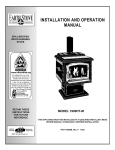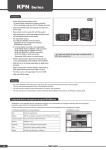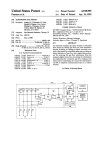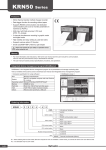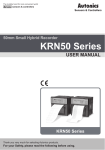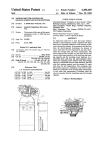Download Engine Blueprinting 101 Part One
Transcript
Technical Engine Blueprinting 101 - Part One Measuring Cam Timing & Lift B LUEPRINTING IS A time-honored method of achieving more power from a production engine. Although the term is often associated with racing, the techniques are equally applicable to the streetbikes that you and I own. Remember that production engines, perhaps aside from the best superbike motors, are not built using the greatest care or very best machining practices, but are objects of mass production, subject to all manner of cost controls and variable production tolerances. This fact gives a careful mechanic the opportunity to improve power significantly with relatively small expense. The term blueprinting means to bring all the dimensions to the ideal numbers called out in the engine’s blueprints, but it can also mean optimizing the range of allowable variations to achieve precisely those that will deliver the best power. We’ll confine our series to the top end, and our current Project Bike, Suzuki’s DR650SE, will be the model, but the techniques shown apply to virtually any engine. The Camshaft The business of the camshaft is to coordinate the openings and closings of the valves on our four-stroke engines, so that on every second revolution, combustion occurs, creating the power that drives our motorcycles forward. The chant “Intake, Compression, Power, Exhaust” that every shop student learns by heart on the first day of class would make you imagine that each phase of the process takes precisely half a turn of the crankshaft, but that’s not true. In fact, the Intake stroke steals time from the Compression stroke and the Exhaust stroke steals time from the Power stroke. The intake valve opens just before the piston starts the downward Intake stroke, and the exhaust valve’s closing is typically delayed by a similar amount, to take advantage of the gas flow inertia at work as the engine runs. By leaving both valves open for a moment as the piston reaches top dead center (TDC) at the end of the Exhaust stroke, the out-rushing exhaust gases will tend to create a suction effect on the intake side, initiating fuel/air flow before the piston’s descent works to create 30 FEBRUARY 2011 ● its own pull. This phase, when both valves are open, is called Overlap. Engines tuned for a broad torque range and good lowspeed power, like our dual-sport, will use a brief overlap period of perhaps 20°, while engines designed for high-rpm power will use from 50°–75°. Long overlap is reserved for high-rpm motors because at lower revs a delayed exhaust closing will tend to backflow into the cylinder, and hot exhaust gas will take up significant space, making filling the cylinder with fresh air and fuel impossible to accomplish. The other valve timing events are similarly adjusted to make the most efficient use of these inertial flow effects. The intake valve won’t close at the bottom of the piston’s Intake stroke, which would seemingly give the rising piston its maximum possible compression. Instead, the engine designer will leave the valve open much longer, abbreviating the Compression stroke, utilizing the inertia of the intake flow to continue filling the cylinder as the piston rises for a significant portion MOTORCYCLE CONSUMER NEWS by Dave Searle of its travel. An engine designed for strong low rpm running will have the intake valves close about 45°–50° of crankshaft movement after bottom dead center (ABDC) on the Compression stroke, while a high-rpm racing engine may keep the intake valves open until 100° ABDC or more. Incidentally, a high static compression ratio is required when the compression stroke is shortened this way, and compression ratios are always figured as if the intake valve(s) close at BDC. Of course, the same backflow situation will happen with late intake closings at low rpm, only this time the intake charge will reverse direction and push back out through the carb or throttle body, reducing volumetric efficiency. This quantity of regurgitated fuel/air mixture will typically be contained in the airbox so it doesn’t escape entirely, but it will then be treated to a second shot of fuel as it is drawn back in on the next intake cycle, ruining its mixture accuracy. Exhaust timing is adjusted so that valves will open well before the piston’s downward Power stoke ends at bottom dead center (BDC). Again, the engine’s intended use will determine when, and tends to range from 45°–50° before bottom to as much as 75° or more. This early-opening scenario is called “blow down” and is done in order to aid in emptying the burnt contents of the cylinder after the combustion pressure has done the majority of its work and before the rising piston expels the remainder. Remember that the volume of the combustion chamber rapidly expands as the piston descends, reducing the effective working pressure on the crankshaft. Aside from the timing of the valve events, which are carved into a fixed arrangement by the hardened steel shapes of the cam lobes, valve lift is the other key to camshaft performance. To see with your own eyes how small a distance the valve actually moves away from its seat is to appreciate the potential for flow increase with higher lifts. (See image) This is a fundamentally different problem than cam timing and duration. We would prefer to open the valves instantly to the full height that will eliminate flow Intake Overlap phase begins before TDC on the Exhaust stroke, so that negative pressure in the exhaust pipe will initiate intake flow before the piston’s descent creates its own suction effect. Compression is cut short by extending the intake cycle to take advantage of inertial ramming. The compression ratio is raised to compensate for the degree of reduced piston travel before closing. Power stroke is cut short by early opening of the exhaust valve, after combustion pressure has done the majority of its work. This is called “blow down” and helps to evacuate the cylinder of burnt gases. the gastank, to ensure that no dirt falls restriction between the valve and its seat, inside the motor when the covers have but we can’t. The lift necessary to elimibeen removed. Make sure that any pasnate any restriction is possible to achieve, sageway into the motor is plugged with but not instantly by any current means, so clean rags or paper towels as you proceed. the accelerations induced in the valve train There’s nothing worse than multiplying must be carefully calculated. The valves, your efforts just to retrieve a clip or springs, retainers and keepers plus shims, washer that’s fallen into the bottom of the rocker arms, clearance adjusters, pushrods motor when it didn’t have to happen. and lifters, if the engine has them, all have their own inertial weight and some are even slightly flexible in addition. The quicker we move the valves, the stronger the valve springs must be to control them, and the highest rpm the engine will attain determines the required spring pressure. This spring force should not be taken lightly when considering a change of camshafts, as even in the best of circumstances, it causes friction and wear between the lobes and lifters, which already constitute one of the most difficult lubrication jobs in the motor. The DR’s intake valve at full lift. The tempOnly the desmodromic system used by tation to increase lift for more flow is great, Ducati escapes this conundrum. but stronger springs may be required, increasing friction, wear and parts expense. Tools On the DR, it doesn’t take much more A factory shop manual is essential. It than an hour to disconnect everything will not only contain nearly all the speciattached to the top of the motor: airbox fications you’ll need, but it will also boot, carburetor, exhaust pipe, oil cooler, illustrate the correct routing of all the sparkplugs, etc. If you carefully put the hoses and wiring you’ll disturb as you various bolts in egg cartons from left to disassemble the machine. right and top to bottom, you’ll find it easy Once again, the DR650’s big singleto reverse the sequence when it’s time to cylinder engine makes disassembly easy put it all back together. Take pictures of and simplifies many subsequent operathe various hose routings with your tions. We found the entire top-end job can digital camera to serve as maps if your be done without removing the motor from service manual doesn’t detail these adethe frame. And, it’s always important to quately. Use masking tape tags to note begin with a clean bike, especially under Exhaust starts early and lasts past TDC to aid intake flow during overlap.Too much overlap can cause backflow into the cylinder at lower rpm, hurting the engine’s ability to draw in fresh air/fuel. which hose goes where. Rather than just dive in, a little time spent on these details will remove a lot of potential stress later. It’s possible the motor will be apart for weeks if you only have time to work on it nights and weekends, like we did, and it’s easy to forget details that seemed insignificant at the time. The DR’s cam timing is not given in the factory service manual, but even if it were, we’d need to verify it. Lift, overlap, opening and closing times and lobe centers are all important information that provide reference points when appraising the degree of tuning from the factory or choosing an appropriate aftermarket cam. Then, if you download the figures for the possible aftermarket cams available, you’ll be able to see how they compare to your stocker. Cam timing that’s off by just 2° at the crankshaft due to manufacturing tolerances will change valve events by twice that amount, which is very significant to how well your motor runs. Adjustable cam sprockets or modifications to your stock sprockets will allow you to correct or alter timing without buying a new cam, but even a new cam needs to be checked and will probably also require adjustment to achieve the intended timing. A minimum of special tools are necessary. You’ll need a large degree wheel that will be attached to the end of the crankshaft, a piston stop, a dial indicator and a holding fixture to secure the indicator in position over the valve spring retainers to measure movement with crankshaft rotation. Visit us at WWW.MCNEWS.COM ● FEBRUARY 2011 31 Technical Precisely set valve lash to zero beforehand in order to read cam timing and get an accurate measurement of lift. You can make a piston stop from an old sparkplug held in a vise. Breaking off the top and pounding on the center electrode with a drift will drive the porcelain through the middle so a length of threaded rod can then be epoxied inside. Be careful not to allow interference between the stop and the valve heads or you could bend a valve. Because the DR has a pair of sparkplug holes, we used the outermost hole to keep a safe distance away from the valves. The length of the stop can be estimated with a thin screwdriver inserted in the plug hole with the engine 10°–15° from TDC. Degree wheels are available from all the camshaft manufacturers and dial indicators and holding fixtures are offered on the internet; $100 can buy all three. The tip of the indicator must contact the spring retainer without being hit by the lifter over the full range of its travel. From that point on, rotate the motor by turning the rotor and not the degree wheel to avoid possible misalignment. Don’t be surprised if this is more difficult than you imagined. Even with the sparkplugs out, the rotor’s magnets and especially the valve springs create significant resistance. This can be minimized on four-valve engines by measuring while only a single valve operates on each side. With the engine at TDC on the combustion stroke Set-Up The first step is to locate Top Dead Center. Of course, you’ll find TDC marked on your ignition rotor, to be lined up with a corresponding point on the engine case, but it can’t be trusted. Manufacturing tolerances allow all sorts of misalignments. Make a sturdy pointer to serve as your degree wheel’s reference point. We made one from the steel rod in a pants hanger, sharpening the end on the bench grinder. Secure the degree wheel so that the engine’s marked TDC corresponds to the pointer. The piston stop is next. This will prevent the piston from reaching the top of the stroke so that by carefully rotating the engine back and forth to reach the stop, the degree wheel will show if the factory mark is perfectly aligned. Any discrepancy will give a different number of degrees BTDC (Before Top Dead Center) and ATDC (After). Move the degree wheel to split the difference and you’ve located the true TDC point. Make sure the degree wheel is then well tightened so that it cannot be shifted accidentally. 32 FEBRUARY 2011 ● Home-made piston stop: Created from an old sparkplug with a vise, hammer and drift, with threaded rod epoxied inside. (both valves fully closed) eliminate the valve lash on the most accessible intake and exhaust valves (left side on the DR). This is easy with the DR’s screw and locknut adjusters. Very carefully turn the adjuster screw by hand until it just stops and then carefully snug the locknut without moving the adjuster any further. On the second intake valve, unscrew the adjuster as much as possible without letting it fall out; this way it won’t compress the valve, saving the extra effort to compress its springs. Do the same on the exhaust side. Shim-adjusted valves in a DOHC engine will require thicker shims to be fitted in order to exactly zero the MOTORCYCLE CONSUMER NEWS With the indicator compressed enough to record full movement and the lifter on the cam’s base circle, zero the bezel. lash. Pro engine builders will leave nothing to chance and measure the timing of every single valve, to make sure that all lobes are matched for duration, lobe center and lift. Position your dial indicator’s tip on the top of the spring retainer on the valve you are measuring, with the gauge compressed far enough that full compression of the valve is within its range, then rotate the indicator’s bezel to align the zero mark with the pointer on its face. Because a rocker arm moves across the valve as it compresses, you’ll find it difficult to ensure that the rocker arm and dial indicator don’t interfere at full lift. Don’t force anything, which could spoil the measurements and possibly damage the expensive indicator, and check to make sure everything is good before proceeding with the measurements. Always turn the crank in the direction of engine rotation. If you exceed your mark, back up a short distance and turn forward again carefully; we don’t want cam chain slack to alter our readings. Get out your notebook and record the measurements. Cam manufacturers will typically give lifts at either .040" (equivalent to 1mm) or .050" (traditional in the US). Be sure to record both these numbers, as well as the additional steps at .100, .150", .200", etc. until the cam lift peaks (record this figure, too) and then as it returns to its seat. We’d suggest you record the smaller numbers; the point of initial movement and steps at finer increments like .010", .020" and .030", also. These smaller lifts happen much more gradually and represent the opening and closing ramps on the cams, designed to smoothly take up slack before moving the valve quickly. Double check your measurements. Repeatability is your assurance it’s correct. Keep working until you’ve achieved this. A slightly loose holding fixture, overtightened adjuster or interfer- opening and closing points but expect you to determine these numbers from the duration and lobe center figures. INTAKE EXHAUST Perhaps the most critical number Lift Degrees Lift Degrees is intake closing as this is where true .040" 4.5° BTDC .040" 46.4° BBDC cylinder compression starts. The .050" 2° BTDC .050" 43° BBDC later the intake closes ABDC, the .100" 11.5° ATDC .100" 28.5° BBDC higher the rpm at which peak torque .150" 24° ATDC .150" 11° BBDC will be produced. Figure that the .200" 37° ATDC .200" 3° BBDC torque peak rises roughly 100 rpm .250" 51° ATDC .250" 11° ABDC later in the power curve for each .300" 67.5° ATDC .300" 61.5° ABDC degree of later intake closing. For .350" 85° BBDC .350" 86° ABDC instance: Do you want more low.361" 73° BBDC .363" 84° BTDC rpm power than stock? Advance the cam. Do you want the same low rpm .350" 51° BBDC .350" 86° BTDC torque as stock? If so, choose a cam .300" 24° BBDC .300" 61.5° BTDC that has nearly the same intake clos.250" 8.5° BBDC .250" 45° BTDC ing as stock. Would you like the ABDC .200" 30.5° BTDC .200" 7° maximum torque 500 rpm later than .150" 19° ABDC .150" 18° BTDC stock? Choose one with the intake .100" 31° ABDC .100" 5° BTDC closing roughly 5° later. .050" 45° ABDC .050" 9° ATDC Lift is obvious. More is typically .040" 48° ABDC .040" 12.5° ATDC better, but to get much more, other changes will usually need to be Intake Duration: Exhaust Duration: made. The stock valve springs may @ .040" lift = 232.5° @ .040" lift = 239° not be strong enough to control the valve accelerations at high speed if @ .050" lift = 227° @ .050" lift = 232° Lobe Center = 111.5° Lobe Center = 107° the lift is much higher. Your cam maker will usually recommend the necessary springs. The stock valveIf stock cam is advanced 4° (@ .040" lift) Intake opens @ 8.5° BTDC, closes @ 44° ABDC to-piston clearance may also be Exhaust opens @ 44.4° ATDC, closes @ 8.5° ATDC inadequate if much higher lift is used. The time-honored method of checking this is to “clay” the clearATDC (After Top Dead Center) ance. You must reassemble the cam BTDC (Before Top Dead Center) and top end, placing pieces of modBBDC (Before Bottom Dead Center) eling clay (lightly oiled on both ABDC (After Bottom Dead Center) sides) in the piston’s valve cutouts, turn the engine over, remove the head, carefully slice through and ence in the indicator’s movement will remove half the clay and measure the thickness. But if you are careful with a digthrow off the measurements. With this done, several important figures ital caliper, you can check clearance withwill be known: Lift, duration and lobe cen- out a mock-up assembly and disassembly. ters. Lift is self-explanatory. Duration is A minimum of additional clearance is necthe time in degrees of crankshaft rotation essary, the precise amount dependent on that the valves are open (given from either the size of the motor and the rpm anticithe .040" or .050" lift points). Higher lift pated (as much as .080" on big exhausts and longer duration with different cams are and up to .100" inch for big intakes) Natthe time-honored ways to add flow capabil- urally the costs of special valve springs ity. The “lobe center” numbers are meant to will need to be calculated (about $200 per be an easy way to visualize the alignment four-valve cylinder) and located as well as point of maximum lift, given in degrees, the expense of piston valve pocket machineither BTDC (for exhaust cams) or ATDC ing if you get greedy with lift. But, as our (for intake cams). For intake cams, you focus is optimizing the stock engine, we divide the duration in half and subtract the don’t have to worry about that. number of degrees the cam opens before TDC during the overlap phase. For exhaust What We Found cams, divide duration in half and subtract As expected, the stock cam is biased the number of degrees the cam is kept open toward the lower end of the rpm range; after TDC during overlap. good for dual-sport and off-road use. With these numbers, it’s easy to com- Supermoto applications would suggest a pare your stock and aftermarket cams. Note new cam that raises the torque peak that aftermarket cams do not specify the maybe 500 rpm; road racing perhaps even DR650SE more. Engine tuning is about compromise; giving up something to get something more in a different place. Analyze your favorite type of riding. What would be ideal? In fact, we learned our DR’s cam timing is retarded by 4° from the common “split” overlap, the intake lobe center at 111.5° ATDC and the exhaust lobe center at 107° ATDC. Such retarded timing is unusual, and evenly split or advanced timing should improve performance, adding effective compression, low-speed power and reducing the tendency for back flow on the intake and exhaust. Although dyno tuning is required to optimize the exact timing figures, we feel comfortable advancing the stock cam timing by 4° to achieve split overlap, which we will cover in Part Four of this series, when we reassemble the motor after verifying and correcting the actual compression ratio in Part Two and cleaning up the ports and machining the valve seats in Part Three. Comparing our stock cam with the most popular aftermarket alternative was also illuminating. The new cam’s timing was almost identical and the new cam’s lift was actually less. Although we’d really need to know all the lift/degree figures to be absolutely sure (which are not normally divulged by cam manufacturers), the comparison suggests we’d be wasting our money if we hoped for more power (and dyno tests by other tuners using this cam back up our numerical analysis). The surprises continue in Part Two, so stay tuned, we think you’ll enjoy the trip. RESOURCES Reading: Four-Stroke Performance Tuning by A. Graham Bell. 3rd Edition by Haynes Publishing. Probably the best single reference book on the subject. Highly recommended. Hardcover $60.98, available from Amazon.com for $23.94, or even less in used condition. Degree wheel: Competition Cams 7.5" Sportsman wheel, Part # COC-4787. $14.25 from www.888murrays.com Central Tools 1"-travel dial indicator with magnetic holding fixture. Mfg # 3D102. Model # 112202, $71.20 from www.toolsource.com. Cam degreeing kit (everything needed) with video. Web Cam # AP-144, $265. Web is also a good source for instructional info. www.webcamshafts.com Visit us at WWW.MCNEWS.COM ● FEBRUARY 2011 33




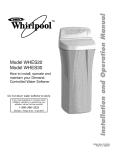
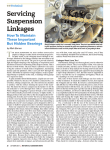
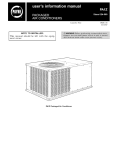
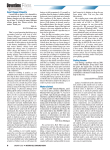
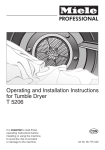
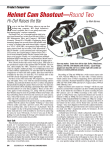

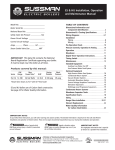
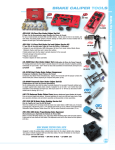
![United StiltBS Patent [19] [11] Patent Number: 5,025,556](http://vs1.manualzilla.com/store/data/006008181_1-2c5f49b6565f7d3a6ea1501cb683eb1f-150x150.png)
